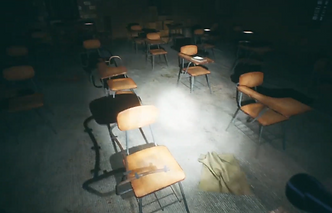
A psychological horror level where players descend into guilt, memory, and punishment inside a haunted elementary school.
Overview
Bell is a first-person psychological horror level set in the haunted remains of William Elementary School. Designed as a single-level experience in Unreal Engine 5, the player explores eight eerie areas in a corrupted school day schedule. As memories surface and ghostly shadows follow, players uncover a devastating truth: they are not a lost student, but a predator reliving their punishment in a cursed loop of guilt and fear.
Created for a Level Design II class, Bell showcases atmospheric horror pacing, emotional storytelling, and Blueprint-based gameplay scripting. Built entirely solo, the level emphasizes exploration, tension, and visual narrative.
Project Type: Horror Level (School Project)
-
Engine: Unreal Engine 5
-
Format: Single-Player, First-Person
-
Playtime: 10–15 minutes
-
Platform: PC (Playable in Unreal Editor)
-
My Role: Solo Level Designer & Developer
-
Development Time: 3 weeks
Key Responsibilities:
-
Designed full layout and gameplay flow (7-section structure).
-
Scripted horror sequences with Blueprints and Horror Engine.
-
Built atmospheric pacing, lighting, and environmental storytelling.
-
Implemented grayboxing, prototyping, and polish cycle solo.
Created at LaSalle College Vancouver – Level Design II Class


Gameplay Mechanics
Bell transforms the familiar spaces of a school into a twisted horror experience. Players explore, survive, and uncover their past by navigating eerie environments, triggering psychological scares, and enduring a final chase, all without combat or guidance.
Exploration & Navigation

Explore 8 areas including classrooms, pool, gym, and bathrooms. Keys unlock progression.
Trigger-Based Horror

Sudden scares and ghost encounters scripted via location triggers and light/sound cues.
Flashlight Mechanics
Final Chase Sequence
Flashlight acquired midway. Limited visibility increases fear in pitch-black classrooms.
Gym transforms into chaos. Player runs through floating debris while shadows scream.
Design Process


Documentation & Planning
The project began with a detailed Level Design Document, outlining the horror experience across eight thematic zones inspired by a corrupted school schedule.
Each room was mapped with its own narrative beat, scare event, and environmental theme.
The design focused on key horror elements, psychological dread, pacing, ghost placement and applied principles such as:
-
Game flow & intensity mapping
-
Navigation, orientation, and signifiers
-
Emotional escalation & narrative discovery

Grayboxing & Blueprint Systems
Using Unreal Engine 5, I first grayboxed the entire layout to define room proportions, sightlines, and scripted event flow.
Core systems were then implemented using Blueprints and Horror Engine:
-
Player controller, flashlight system, UI prompts
-
Key and note pickups with inventory logic
-
Ghost triggers, ambient audio, lighting effects
-
Final chase sequence using AI pathing and cinematic scripting
This phase was essential to prototype rhythm and tension before final art dressing.

Environment & Horror Implementation
Each zone was polished with custom lighting, modular assets, and immersive sound design to match its emotional purpose:
-
Pool Room – Shark scare & drowning hands
-
Classrooms – Lightbulb explosion & flashlight gameplay
-
Girls’ Washroom – Mirror ghost jumpscare
-
Gym – Floating debris & full chase finale
Every moment was planned to maximize suspense using environment, silence, and atmosphere, not just jumpscares.

Challenges & Learnings
Time Pressure & Scope
Delivering a full atmospheric horror level in just three weeks was the most demanding challenge. I had to plan, design, prototype, and polish seven distinct gameplay zones alone, while ensuring strong horror pacing and quality.
I worked on:
-
Prioritizing core horror beats over optional features.
-
Using modular grayboxing for layout, timing, and sightline planning.
-
Streamlining tasks: documentation, asset placement, and event scripting.
This taught me how to scope effectively, maintain a clear development pipeline, and still deliver a polished experience within tight academic deadlines.

Narrative & Player Guidance
Creating a subtle, environmental story while guiding the player naturally through eight horror sections required careful pacing and visual flow.
I worked on:
-
Applying signifiers, lighting cues, and sound triggers to guide movement.
-
Using environmental storytelling to hint at story progression and twists.
-
Making each zone readable while preserving mystery and fear.
This process helped me refine my use of level design principles (affordance, orientation, navigation) to create immersive, story-driven horror spaces.

AI, Blueprints & Polishing
Designing the ghost AI behavior and final chase using the Horror Engine and custom Blueprints added technical complexity to the project.
I worked on:
-
Creating dynamic scare triggers and chase logic via UE5 Blueprints.
-
Scripting camera transitions and cinematic sequences.
-
Integrating UI prompts, flashlight control, and horror stingers.
This experience made me more confident in Unreal Blueprint workflows, and taught me to solve problems with modular systems and rapid iteration.




